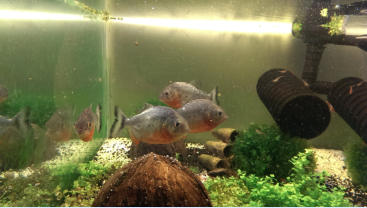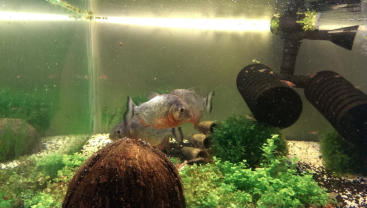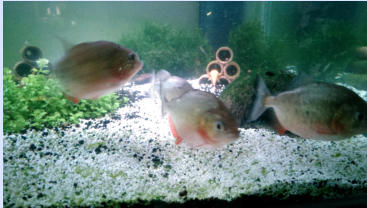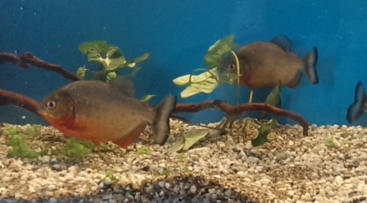

Red Belly Piranha
Caring & Breeding Red Belly Piranha’s
Description: Description: The red-bellied piranha has a reputation as one of the most dangerous freshwater fish in the world. Their mouth is full of sharp, triangular teeth, which can be torn carcass meat. The fish is mostly silver, with a red spot in the silver eye rim. He has a dark gray head with an orange-red throat area. Just as the name implies, is the belly of the red-bellied piranha red. Nevertheless, this is not the case in juveniles, which have a gray, dotted abdomen. The maximum length is 33 cm and weight 3.5 kg This species is widely spread across the world in rivers in central and southern South America east of the Andes Mountains and north of the Rio Parana / Paraguay in Argentina and Paraguay. In addition, this species is found in coastal rivers in eastern Brazil and he is turned into artificial ponds in the north-east of Brazil, for the benefit of the local food and international aquarium fish trade. lifestyle: The red-bellied piranha food consists mainly of fish, insects, worms, snails and occasionally a larger animal. Also, seeds and fruits are sometimes eaten. Contrary to their reputation, the red-bellied piranha eats mostly dead and sick or injured animals, but sometimes it is a healthy animal. The red-bellied piranha eats in large schools around sunrise and sunset. They locate their prey by a set of sensors on the side of their body called branch lines. appearance: Red Piranha has many forms, patterns and colors, depending on the reference in the wild (geographic varieties). Some specimens have a blood-red belly and lower jaw (called. Pygocentrus nattereri var. "Super Redbelly"), others are more orange or yellow (Pygocentrus nattereri var. "Ternetzi"). These differences are caused by differences in habitat (camouflage), water chemistry, diet, presence or absence of strong currents, and other factors. The color of the belly is about halfway to the sidelines: above the body is darker in color: silver-colored, steel gray, bluish, black, sometimes with a greenish or purplish glow. In proportion as the fish ages, the slopes are covered with small silvery scales, which under the right light have a beautiful iriscerend effect. The thoracic, abdominal and anal fins are usually roughly the same color as the abdomen (usually slightly darker), while the other fins are translucent gray or black. The tail has a bright vertical band in the middle, and is big and powerful, giving the Red Piranha short distances can bridge very quickly. The profile of the head is convex, with a particularly powerful and muscular jaw studded with sharp triangular teeth. The upper jaw has teeth similar, but smaller in size, if the fish closes its mouth, fit teeth of upper and lower right together, as it were like a bear trap. The teeth are at most a few millimeters wide, and are replaced by row: piranhas keep exchange for practically their entire lives teeth. Only very old specimens miss sometimes permanently teeth. The eyes are in the majority of cases of red color (from a centimeter or 8-10: younger ones have silver eyes). However, there is also some geographic varieties with silver eyes. A dark band running diagonally through the eye to camouflage. The nostrils are highly visible, and with a small flap of skin which water flows in guiding the nose: piranhas have a very well developed sense of smell, and can observe to a great distance blood in the water Feeding: Cultured Red Piranhas are particularly easy when it comes to flying: almost all foods, prepared and living, will be accepted without problems. Consider items like fish (fillets, frozen and alive *), shellfish and crustaceans (shrimp, krill, crab and lobster, mussels), insects (earthworms, mealworms, flies) and the 'lovers' of horror in the aquarium even small mammals (mice, rats, hamsters - definitely not recommended due to the risk of injury, the introduction of pathogens and the mess you'll stay with it - her in the filters!) In addition, on a small scale, that is, not more than once are conducted every month by way of a treat, beef, pork, poultry and organ meats (beef heart) make sure it is 100% fat free and free of herbs, spices and other unnatural additions, there are piranhas difficulty digesting these substances (because of the inherently higher fat content of these items should also be fed sparingly!) In addition to the animal diet can also prepared food items like dry food with animal and / or plant materials (pellets, tablets, flakes), dried and frozen food (mosquito larvae, blood worms), and in some cases even vegetables, fruits, seeds and nuts. Whatever one chooses as main part of the diet, it is important to provide a varied diet possible. An excellent way to create a nutritious and varied diet is making your own feed cubes: make a coarse mixture of the ingredients you want to use, and optionally vitamin / nutritional supplements, mixing this with gelatin and pour the mixture into ice cube trays. Vries then in this. Red piranhas, like the other Pygocentrus-piranhas, catch their prey by active hunting piranhas are in a group of schools of fish, and take bites out of anything they can get their teeth into. Injured prey animals are then hunted down and devoured by the group. This hunt might take some time, there are piranhas admittedly pretty fast swimming fish, but high speeds but hold short sex. Solitary fish rely more on the ambush technique: from a hiding place throw themselves on unsuspecting prey fish, to kill in most cases with a mouth full of scales and fins to run off instead of fish. Breeding: A clutch is usually consists of 1000 rather large eggs, which are deposited in the water hanging tree roots. The clutch is monitored by both parents until the eggs hatch after 9 or 10 days Size: The maximum length is 33 cm and weight 3.5 kg . Aquarium size: Young and immature specimens can be temporarily held in smaller aquariums, depending on the numbers and size: less than 80-100 cm should not, however, an aquarium, because of lack of space leads to stress and aggressive behavior, injured or even dead fish as a result . In adult fish must be at least 80-100 gallons per fish be taken as a rule of thumb, a minimum tank size of 150 centimeters in length and 50-60cm. deep and high. To schools of six or more fish is 30cm. aquarium fish length by a good standard. Red piranhas are notorious for their nervous and even timid character (in stark contrast to their highly exaggerated reputation) so long as the fish are not accustomed to human presence, in general, and their 'boss' in particular, they tend to at the slightest panic by putting the bin in search of a shelter. There is a piranha panic little attention to his surroundings is to use it for decoration pieces recommended with sharp edges, as this can lead to injuries, which in turn can attract the attention of hungry peers or lead to secondary infections. Round pieces of driftwood, pebbles and many plants on the other hand excellent for the establishment of a piranha aquarium, and its presence will have a calming effect on the fish Water parameters: 23 - 29C Degrees, PH Range 5.5 - 7.8




















































